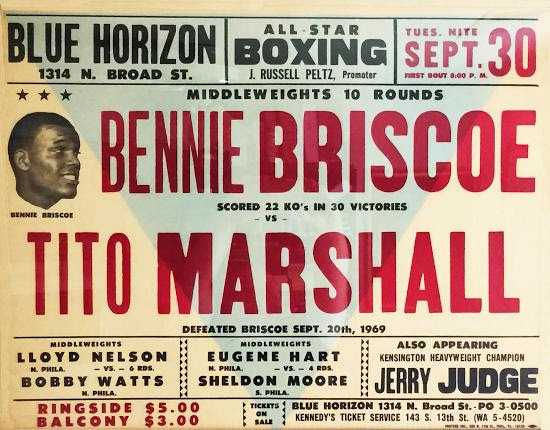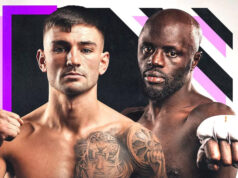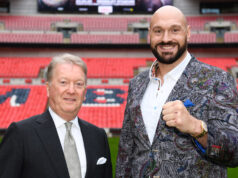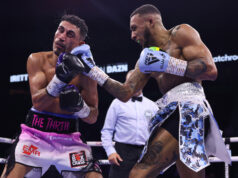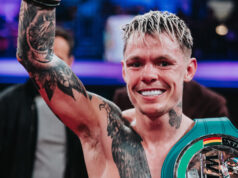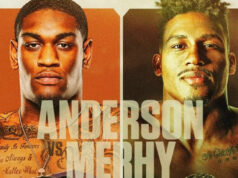While preparing for Friday’s Puerto Rican Boxing Classic at the 2300 Arena in Philadelphia, promoter J Russell Peltz, International Boxing Hall of Fame, class of 2004, recalls his start in boxing 46 years ago…
Today I celebrate-or perhaps observe-the 46th anniversary of my first fight as a boxing promoter. I could have waited another four years to write this story, but that seems like a long time from now and an even longer bet to reach that milestone.
I saw only a few minutes of my first boxing card. It was Sept. 30, 1969, at the Blue Horizon-not yet legendary-and I was busy in the box office with mom, selling tickets to the last of the 1,606 people we squeezed in there that night to watch middleweight Bennie Briscoe destroy Tito Marshall in their rematch. We actually turned people away that night and that’s something I would never do again. What was I thinking?
There was a miscommunication with the union that supplied the ticket sellers so when they failed to show, I hired mom-gratis, of course-and she helped to sell the tickets.
I was 22 years old, 15 months after graduating from Temple University and less than 30 days removed from working full-time on the sports staff at The Evening Bulletin. I had coveted the boxing beat at The Bulletin, but I got impatient when Jack Fried, the boxing writer, got an extension on his mandatory retirement at age 65 and I wasn’t about to hang around waiting for him to retire or, as dad would say, kick the bucket.
So I did what every 22-year-old college grad who was raised on the prestigious Main Line would do-I became a boxing promoter.
I had saved about $5,000 in college since I had worked full-time on what they called the Lobster Shift at The Bulletin, starting the summer after my junior year at Temple. I worked from midnight to 8 am, editing stories, writing captions and headlines and doing re-writes. Then I’d drive from 30th & Market Street to North Broad Street for my senior year at Temple, go to class from 9 am to 1 pm, then drive home to Bala Cynwyd to go to sleep.
It was a post-Olympic year in Philly and there was talent on every street corner. I remember the late summer of 1969, driving up Columbia Avenue-now Cecil B. Moore-and turning right after 22d Street where Columbia turns into Ridge. Two buildings from the corner stood the aptly named Roach’s Café. On top of Roach’s Café, up a steep flight of stairs, was Champs Gym, run by Quenzell McCall, who had made his bones training Percy Bassett and Leotis Martin and Kitten Hayward and Briscoe and many other top Philly fighters.
I met Sam Solomon, a friendly round-faced man who owned a Laundromat in West Philadelphia, and he introduced me to his new fighter, a 17-year-old stud who was looking to turn pro. His name was Eugene Hart. Sam nicknamed him Cyclone.
A year earlier, at a gym in the basement of the Annunciation Church at 12th & Norris, just off Temple’s campus, I had interviewed another young amateur boxer for a story I wrote for The Bulletin. His name was Bobby Watts. They called him Boogaloo.
There had not been a pro fight card in Philly since May and local fans were ready for some action.
I had dreamed of having my boyhood idol, Hall-of-Famer Harold Johnson, in the main event but I could not afford the $2,000 he wanted. I had become friendly with Pat Duffy, having written some stories about amateur boxing while I was at The Bulletin. Duffy controlled the amateurs in the tri-state area and he had his hand in the pros as well. He was involved with Leotis Martin and Sammy Goss and Bennie Briscoe and for a guarantee of $1,000 against a percentage of the gate receipts I got Briscoe to fight a rematch with Marshall, who had beaten Bennie four years earlier.
Duffy also had a heavyweight named Jerry Judge, from the Kensington section of Philly, and I added him to the card in his pro debut. On the poster I identified Judge as the Kensington Heavyweight Champion. Really!
George Hill, who was training at Champs Gym, agreed to make his own pro debut against Judge.
Jimmy Toppi, Jr., owned the Blue Horizon. He had promoted fights at various Philly venues in the 1940s and 1950s and as soon as he heard about my main event, he predicted a sellout. Toppi would close his office every day at 2 pm, so I would drive over to the Blue Horizon from my apartment in the Germantown section of the city, park outside and wait to see if any customers would show up to buy tickets. Whenever I saw someone ring the doorbell at the Blue Horizon, I’d get out of my car, call over to them and sell them tickets out of my trunk.
The card came together, although Watts’ original opponent, North Philly neighbor Lloyd Bad News Nelson, canceled out a couple of weeks before the show and it wasn’t until close to Sept. 30 that I found Ron Nesby, who was training at Gil Clancy’s gym in New York.
Dad was in the plumbing, heating and air-conditioning business and he took 100 ringside tickets and gave them out to his business associates. He paid me for all of them-they were $5 apiece. I guess he was worried I wouldn’t make it in boxing. My uncle Bob came to the fight and he got sick after eating a Blue Horizon hotdog.
I was at the gyms every night, Champs and the 23rd PAL in North Philly, Passyunk and the Juniper Gym in South Philly. There were others but those were the Fab Four.
Malcolm “Flash” Gordon, a long-haired New York boxing junkie who had bought a mimeograph machine with his Bar Mitzvah money years earlier, agreed to sell his now-legendary programs at the fight for 25 cents each.
Tom Cushman, the boxing writer for the Daily News, was a major player. I had met Cushman in Oklahoma City a few years earlier. He had stopped there–on his way East from Denver to start his new job at the Daily News-to cover Temple’s basketball team in a Christmas tournament and I was there as a correspondent for The Bulletin.
Cushman knew that boxing writers from other newspapers in town took money under the table from promoters to write pre-fight stories and he told me if he ever caught me doing that I could kiss our friendship goodbye. Not a chance!
The Inquirer headline the day before my card: Is Peltz Ready To Get Skinned?
We sold out. At the time, the 1,606 fans in attendance represented the largest crowd in the Blue Horizon’s history. The gate was $6,010 with tickets priced at $3 and $5. Briscoe’s percentage came to $1,314.58 and Marshall walked out with $788.75.
Middleweight Oscar Coor beat Clarence Finney in an all-local four-rounder to open the card-on time, naturally, at 8 pm-and Cyclone Hart blew away South Philly’s Sheldon Moore, who didn’t answer the bell for round two. Jerry Judge worked hard and stopped George Hill in the fourth round and Boogaloo Watts out-boxed Ron Nesby in a 6. In the main event, Briscoe had a blast. He nailed Marshall below the belt early and when Tito complained to the ref, Bennie went upstairs and it was all over in 60 seconds. Marshall never boxed again.
Columnist Sandy Grady was there from The Bulletin. His story the next day–Crazy Dream Comes True–told about my prediction in college that one day my friends would be coming to my fight cards. He also wrote that my (first) wife and I were living in an apartment in Germantown and the only things in it were a mattress, a TV set and a cat named Ophelia. With the money we made that night ($1,438.83), Grady wrote that perhaps now we would buy some furniture.
A few months earlier, my wife had asked me what made me think I could be successful in this business. I told her that it would take me about six months to blow my savings but I’d have a great scrapbook one day to show our kids about the time their daddy was a boxing promoter.


